Introduction
In an increasingly interconnected digital landscape, the resilience of IT infrastructure has become paramount for organizations striving to maintain operational continuity. Self-healing infrastructure emerges as a transformative solution, enabling systems to autonomously detect and rectify failures, thus minimizing downtime and enhancing reliability.
This article delves into the fundamental concepts of self-healing infrastructure, its significance in modern IT strategies, and provides a comprehensive guide for organizations looking to implement these advanced systems. By understanding the challenges, best practices, and future trends associated with self-healing technologies, businesses can position themselves to navigate the complexities of today's technological environment while ensuring robust performance and customer trust.
Understanding Self-Healing Infrastructure: Key Concepts and Importance
Self healing infrastructure refers to networks and architectures capable of automatically identifying and recovering from failures without human intervention. This capability is increasingly crucial in today's fast-paced digital environment, where even minimal downtime can result in substantial financial losses—at the lower end, just 1% downtime translates to over 87 hours of halted operations annually, underscoring the critical need for an effective IT disaster recovery plan. As Scott Jack from E-N Computers observes, for small to medium-sized businesses with minimal setup, downtime can cost an 'extremely conservative' $1,670 per minute, accumulating to around $100,000 an hour.
Key concepts of self-healing systems include:
- Automation: Leveraging scripts and software to continuously monitor systems and automatically initiate recovery processes.
- Self-Diagnosis: The ability for systems to autonomously identify issues and determine suitable corrective actions.
- Resilience: Designing systems that can withstand disruptions and recover swiftly.
The significance of self-healing systems is underscored by its capacity to:
- Minimize operational disruptions through automatic issue resolution.
- Enhance system reliability and performance, ultimately improving user experiences.
- Reduce reliance on manual intervention, allowing IT resources to focus on strategic initiatives.
As noted in a recent LogicMonitor survey, common causes of downtime include network failures, usage spikes, and human errors. To mitigate these risks, companies are increasingly adopting monitoring tools and conducting load testing. A notable case study is Queue-it's virtual waiting room solution, which effectively manages surges in online traffic, thereby preventing website overload during peak times.
This implementation exemplifies resilience and operational efficiency, leading to improved online experiences, reduced scaling costs, and heightened efficiency during critical sales and registrations.
In conclusion, understanding these key concepts is essential for organizations aiming to leverage technology for enhanced business outcomes. Self-repairing systems, as part of a comprehensive IT disaster recovery plan, are a crucial element of modern IT strategy, allowing firms to establish self healing infrastructure that ensures operational continuity and builds customer trust.
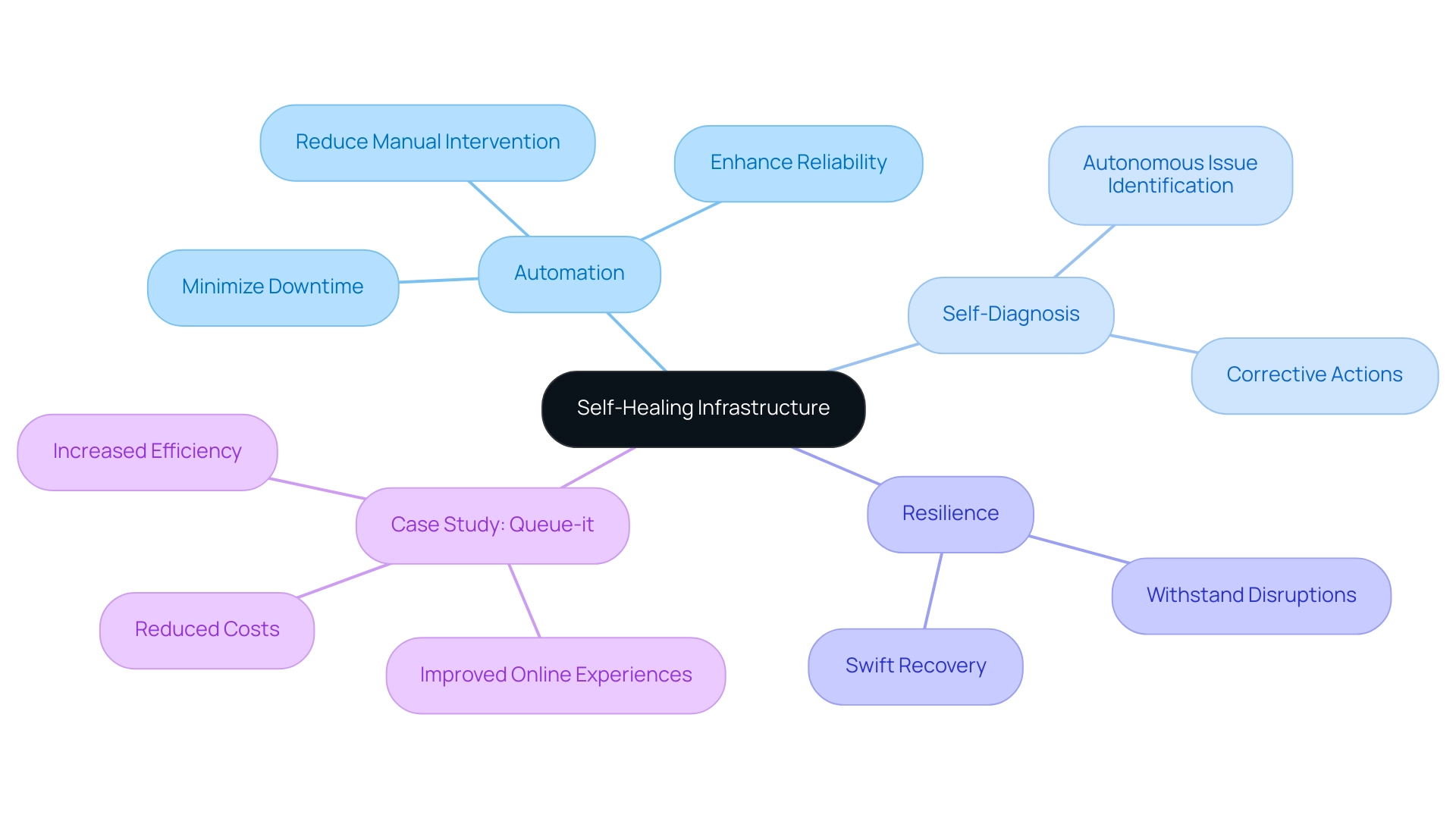
Step-by-Step Guide to Building a Self-Healing Infrastructure
Constructing a self-healing infrastructure necessitates a strategic approach, comprised of several crucial steps:
-
Assess Current Infrastructure: Initiate the process by conducting a thorough evaluation of your existing systems. Identify vulnerabilities that require automation and resilience enhancements. This assessment is vital for recognizing potential failure points and defining the scope of the autonomous infrastructure.
-
Define Recovery Objectives: Clearly establish your recovery time objectives (RTO) and recovery point objectives (RPO). These metrics are essential for informing the design of autonomous repair mechanisms, ensuring alignment with overarching business requirements. Realistic RTOs, which help minimize downtime and reduce financial impacts, play a pivotal role in facilitating swift recovery and resumption of operations. For instance, organizations should aim for RTOs that align with their business continuity goals, ensuring that recovery efforts are both effective and efficient.
-
Choose the Right Tools and Technologies: Opt for tools that enhance automation, monitoring, and recovery capabilities. Leading options in 2024 include orchestration tools such as Kubernetes, monitoring solutions like Prometheus, and automation frameworks like Ansible, each of which supports the seamless integration of automatic recovery functionalities.
-
Implement Monitoring Solutions: Deploy robust monitoring solutions capable of detecting anomalies and triggering self-healing actions. Ensure these tools are fully integrated with your infrastructure to provide real-time insights and alerts, augmenting your disaster recovery plans that must encompass scenarios like natural disasters disrupting supply chains.
-
Develop Self-Healing Scripts: Craft scripts that automate recovery processes for common operational issues. For instance, should a server experience downtime, a pre-configured script can automatically restart the service or initiate a new instance, thereby enhancing resilience.
-
Test and Validate: Engage in comprehensive testing of your recovery mechanisms to confirm their efficacy. Simulate different failure scenarios to confirm that automatic recovery processes activate as intended and that operations recover within the established RTO and RPO metrics. As illustrated in the case study on Recovery Time Actual (RTA), understanding the real-world time taken to restore systems after disruptions is crucial for refining these objectives.
-
Monitor and Optimize: Continuously scrutinize the performance of your automated system, gathering data on its operational effectiveness. Utilize this information to enhance and optimize autonomous recovery processes over time, fostering a culture of continuous improvement that is critical for maintaining robust business continuity. As highlighted by IT expert Claire Mulligan, "Monitoring and continuous improvement are essential for adapting to new challenges and ensuring that systems remain resilient."
By diligently adhering to these steps, entities can effectively create a self-healing infrastructure that enhances resilience, minimizes downtime, and improves overall operational efficiency.
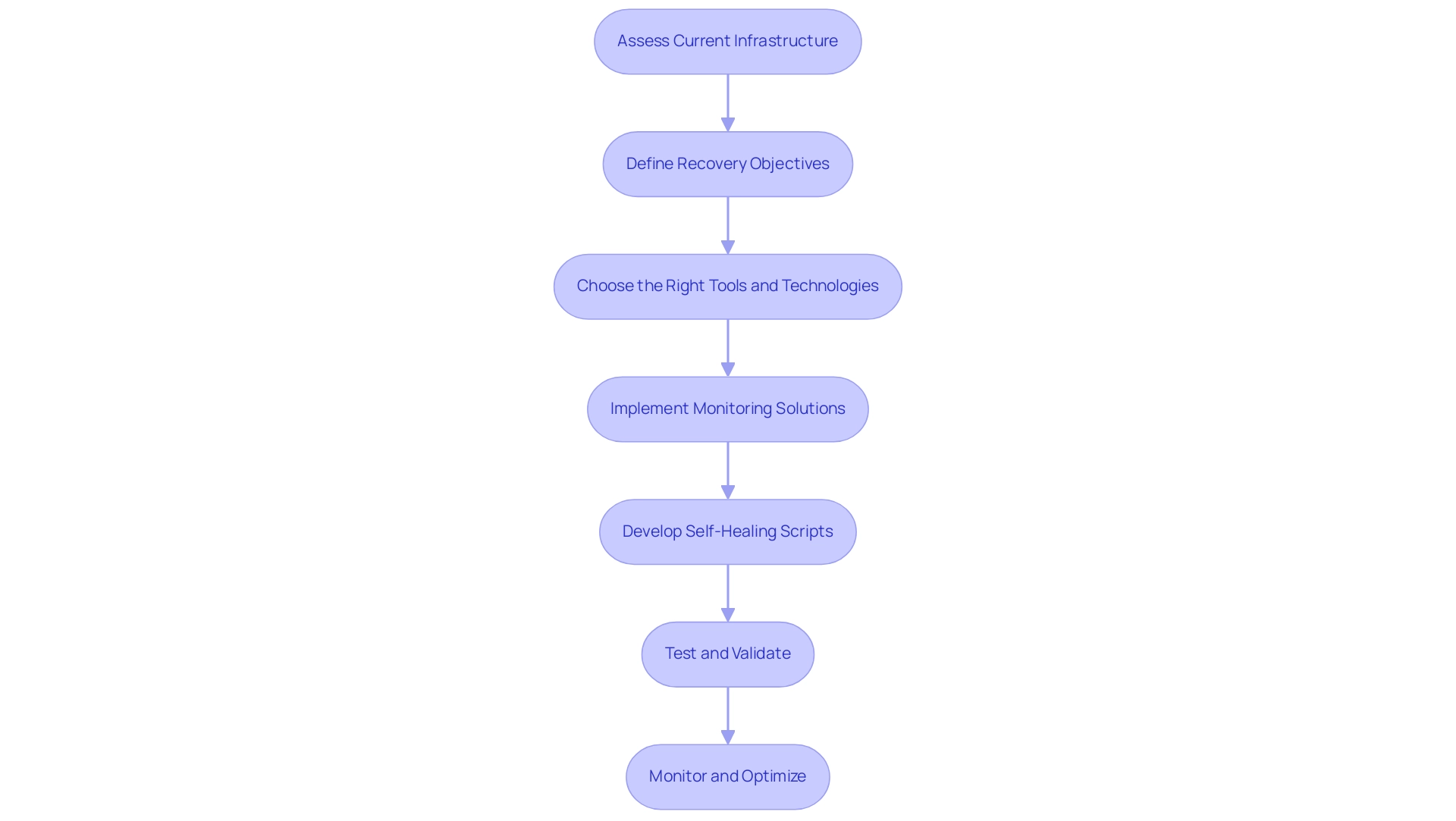
Identifying Common Challenges in Implementing Self-Healing Infrastructure
The introduction of autonomous recovery infrastructure presents a range of challenges that organizations must navigate effectively:
-
Complexity of Integration: The incorporation of autonomous recovery features into pre-existing systems is inherently complex. It demands meticulous planning and execution to mitigate disruptions that could impact operations.
-
Cultural Resistance: Employees often exhibit resistance to alterations in established processes. To facilitate a smoother transition, it is critical to communicate the advantages of autonomous recovery technologies and offer comprehensive training that underscores these benefits.
-
Resource Constraints: Financial or staffing limitations can hinder the adoption of autonomous recovery technologies. Organizations must prioritize strategic investments and secure stakeholder buy-in to overcome these limitations effectively.
-
Reliance on Accurate Monitoring: The success of autonomous repair systems hinges on precise monitoring and issue detection. Inaccurate data can compromise the effectiveness of responses, leading to potential operational setbacks.
-
Testing and Validation: Comprehensive testing is crucial to guarantee that autonomous recovery processes operate as expected, which can be laborious and resource-demanding.
Given the terrestrial acidification index indicating a 69–75% decline, entities can contemplate the ecological advantages of embracing autonomous recovery technologies as a motivating factor for execution. By proactively recognizing these challenges, organizations can develop focused strategies to tackle them, paving the way for a more successful implementation of autonomous systems. Emphasizing the importance of training, as noted by industry experts, is vital:
Improve warehouse efficiency by training your team on Lean principles, using technology, and holding regular sessions.
This approach not only fosters a culture of adaptability but also enhances employee engagement with the new technologies. Furthermore, maintaining team motivation during project difficulties through support and positivity is essential in overcoming resistance to restorative technologies. The case study titled 'Venture Capital: Earning Investor Trust Quickly' illustrates methods for fostering trust in new technologies, which can be crucial in tackling the challenges of implementing autonomous systems.
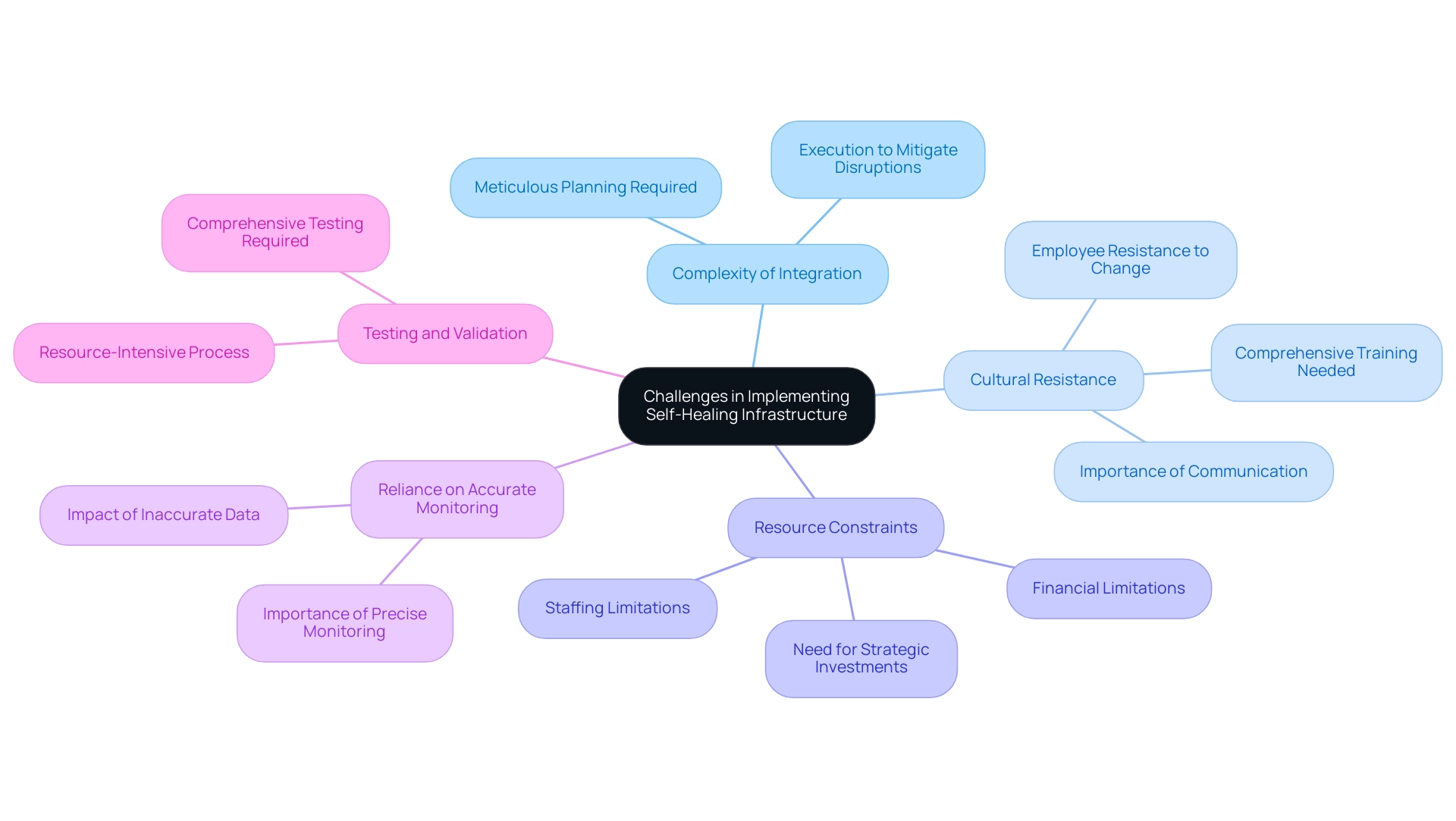
Best Practices for Maintaining a Self-Healing Infrastructure
To effectively maintain a self-healing infrastructure, organizations should adhere to the following best practices:
-
Regular Updates and Patching: Keeping all software and tools current is essential for mitigating vulnerabilities and enhancing functionality. Regular updates not only protect against potential threats but also improve overall performance, contributing to the 65% of businesses that prioritize cloud investments for enhanced security and compliance.
-
Continuous Monitoring: Implementing robust monitoring systems is crucial for identifying emerging issues early and ensuring that self-healing processes operate as intended. Continuous monitoring enables organizations to respond proactively to incidents, which is increasingly critical; after all, 65% of businesses now prioritize cloud investments that enhance security, compliance, and incorporate self healing infrastructure. As noted by industry experts, "Continuous monitoring is the backbone of a self healing infrastructure, which allows for immediate detection and response to threats."
-
Documentation and Knowledge Sharing: Comprehensive documentation of systems, processes, and changes is vital for promoting knowledge sharing among team members. Effective documentation fosters collaboration and ensures that critical information is readily accessible, enhancing the organization's resilience.
-
Periodic Testing: Establishing a schedule for regular testing of autonomous recovery processes is necessary to validate their efficacy. Organizations should analyze performance data to identify areas for enhancement, thus ensuring that recovery mechanisms remain effective under varying conditions. The case study titled 'Multi-layered Security Approach' exemplifies this practice, showcasing how combining various security controls and technologies can improve resilient infrastructure through regular audits and assessments.
-
Feedback Loops: Establishing systems for input from users and stakeholders is crucial for enhancing autonomous recovery abilities. Actively gathering insights helps companies adapt their systems to meet changing business needs and user expectations.
By adopting these best practices, organizations can create a self healing infrastructure that sustains a strong and adaptable automated system, aligning with the changing needs of the business environment. As Classic Network and Computers aptly state,
We are committed to helping our clients navigate these changes and implement robust IT solutions that drive success,
underscoring the importance of a proactive approach to IT management.
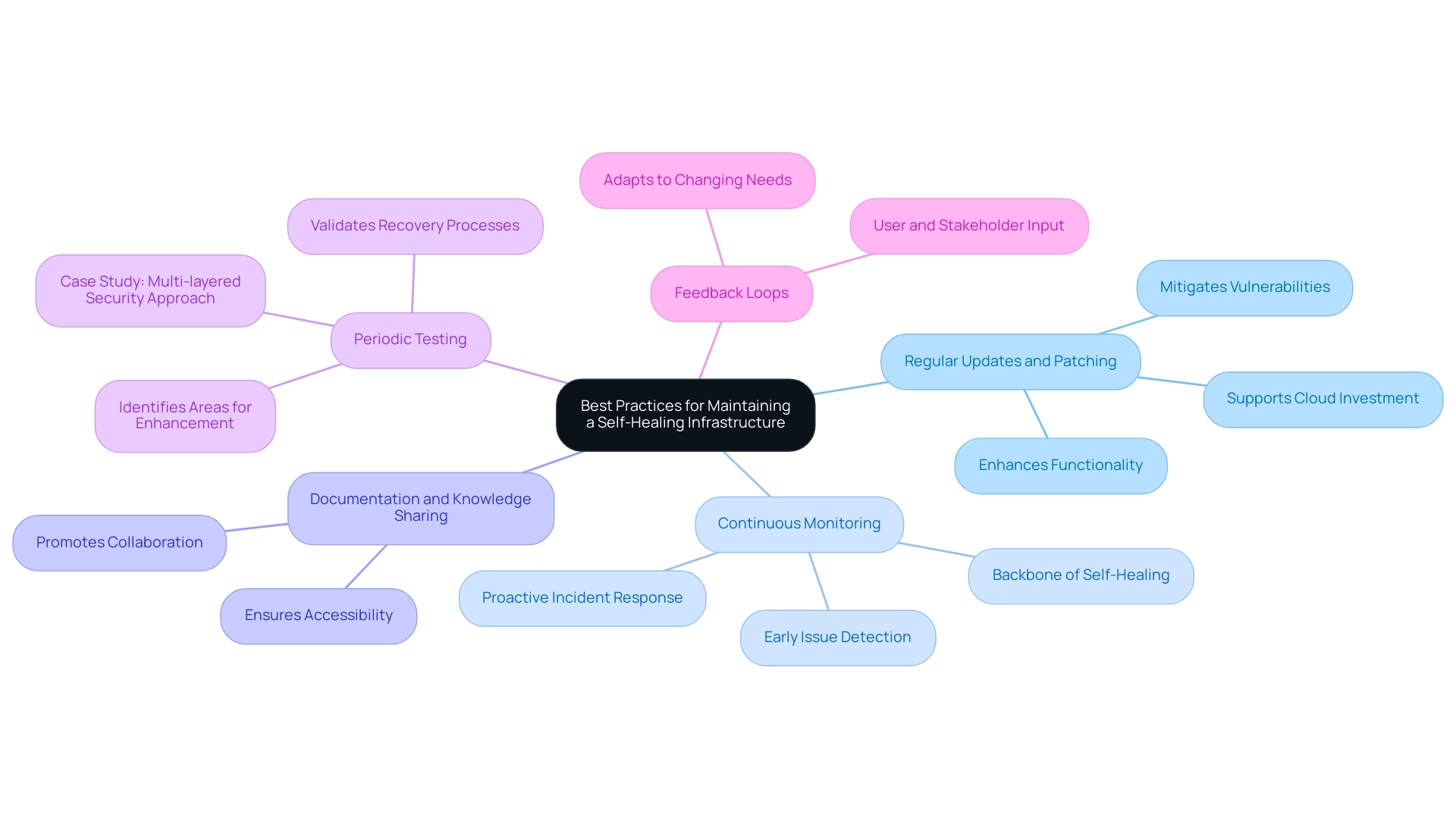
Future Trends in Self-Healing Infrastructure
As technology advances, several pivotal trends are poised to shape the future of self-healing infrastructure:
-
The integration of Artificial Intelligence and Machine Learning is set to revolutionize the self-diagnosis and recovery capabilities of self healing infrastructure. These technologies will enable more intelligent and adaptive responses to failures, significantly enhancing operational resilience. For instance, the UAE is adopting restorative concrete due to its extreme environmental conditions and rapid urbanization, showcasing a real-world application of these technologies.
-
Enhanced Automation: The path towards advanced automation will continue, enabling entities to create complex automated processes that reduce the necessity for human involvement. This shift not only optimizes efficiency but also aligns with the need to manage tight IT operations budgets effectively. As one expert noted, "Improve warehouse efficiency by training your team on Lean principles, using technology, and holding regular sessions," emphasizing the role of technology in enhancing operations.
-
Cloud-Native Architectures: The shift to cloud-native systems will act as a catalyst for implementing autonomous recovery features. By utilizing the dynamic characteristics of cloud environments, companies can ensure their systems remain agile and responsive to changing conditions.
-
Edge Computing: With the rise of edge computing, autonomous recovery infrastructure will need to evolve to effectively manage distributed networks. This adaptation is vital as entities increasingly depend on decentralized data processing.
-
Focus on Security: In an era marked by escalating cyber threats, adaptive systems must incorporate robust security measures to safeguard against vulnerabilities and potential attacks. This focus on security is essential for maintaining high-quality standards across diverse projects within IT operations, which is a key focus in QA workflow.
By remaining attuned to these trends, organizations can proactively refine their self healing infrastructure strategies, thereby ensuring they maintain a competitive edge and robust resilience in an ever-evolving technological landscape.
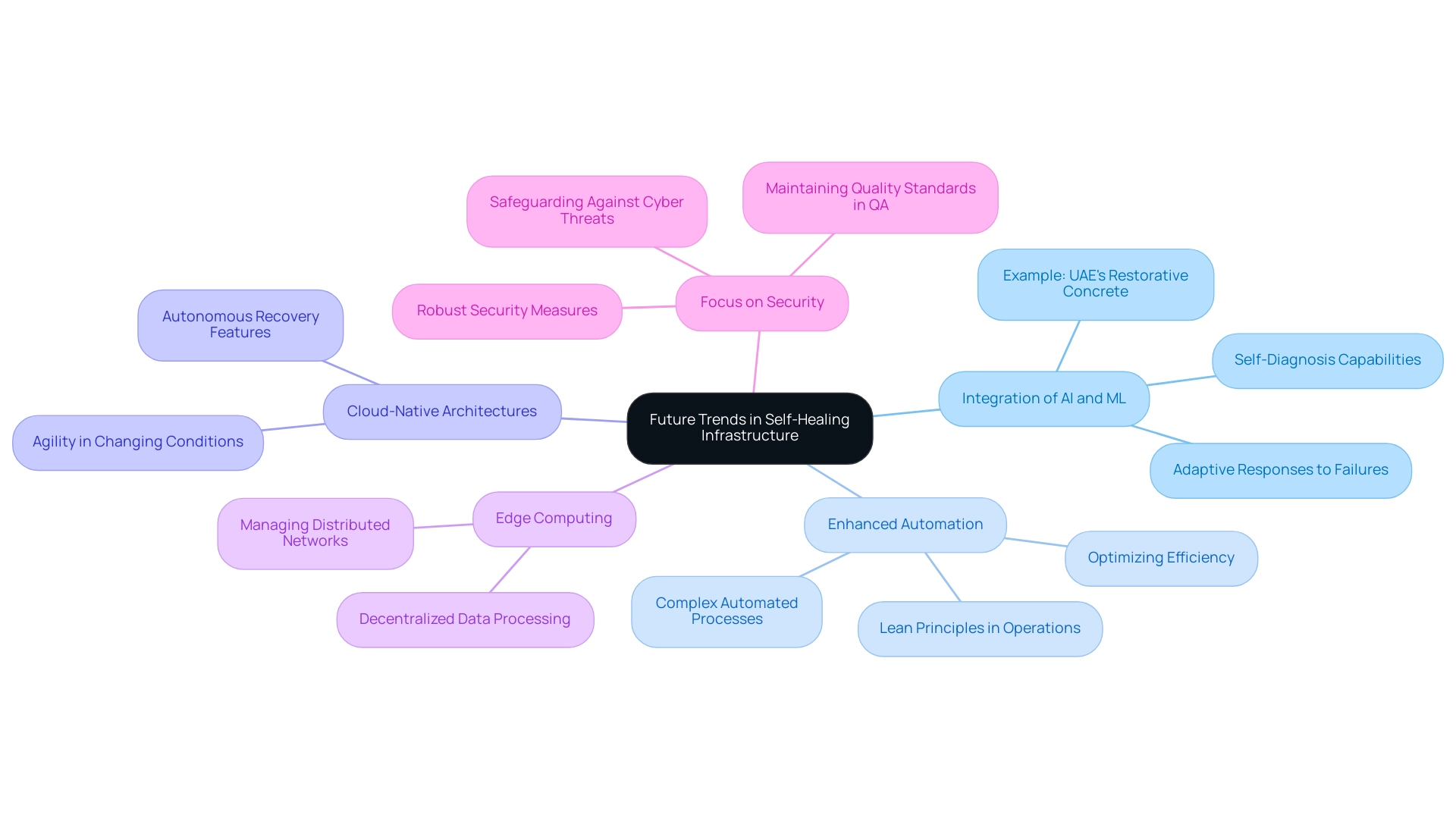
Conclusion
Self-healing infrastructure represents a critical advancement in IT management, enabling organizations to autonomously detect and resolve failures, thereby minimizing downtime and ensuring operational continuity. By understanding the fundamental concepts such as automation, self-diagnosis, and resilience, businesses can effectively implement strategies that enhance system reliability and performance.
The process of building a self-healing infrastructure involves several strategic steps, including:
1. Assessing current systems
2. Defining recovery objectives
3. Selecting the right tools
Furthermore, organizations must navigate challenges such as:
- Integration complexity
- Cultural resistance
While adhering to best practices like:
- Continuous monitoring
- Regular updates to maintain resilience
Looking ahead, trends such as the integration of artificial intelligence, increased automation, and the shift towards cloud-native architectures will continue to shape the landscape of self-healing infrastructure. Organizations that embrace these advancements will not only enhance their operational efficiency but also build a robust framework capable of adapting to the complexities of modern IT environments.
In conclusion, adopting self-healing infrastructure is not merely a technical enhancement; it is a strategic imperative for organizations aiming to thrive in an increasingly digital world. By prioritizing these technologies, businesses can foster resilience, protect customer trust, and secure a competitive advantage in the dynamic marketplace.




